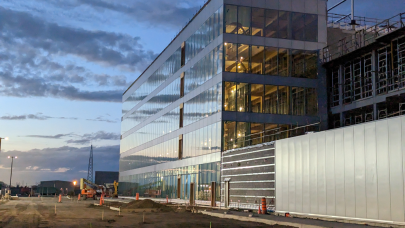
Another Top 5 Trends in HPC for the First Six Months of 2023
July 17, 2023
Editor’s note; Recently Google's Bard provided what it considered the Top 5 Trends in HPC for the First 6 Months of 2023 to HPCwire. While the answers Read more…

NREL’s Kestrel Supercomputer Begins to Land
April 10, 2023
About a year and a half ago, HPE announced that it had been selected to build the next supercomputer for the DOE’s National Renewable Energy Laboratory (NREL) Read more…

A Zettascale Computer Today Would Need 21 Nuclear Power Plants
February 21, 2023
If a zettascale computer were assembled using today's supercomputing technologies, it would consume about 21 gigawatts, or equivalent to the energy produced by 21 nuclear power plants. The math was presented in a keynote speech by AMD CEO Lisa Su at the ISSCC trade show being held in San Francisco held this week. A zettaflop supercomputer would have the computing capability... Read more…

At SC22, Carbon Emissions and Energy Costs Eclipsed Hardware Efficiency
December 2, 2022
The race to ever-better flops-per-watt and power usage effectiveness (PUE) has, historically, dominated the conversation over sustainability in HPC – but at S Read more…

Quebec’s QScale Pushes for Colder, Greener HPC in North America
November 3, 2022
In Levis, Quebec – just outside Quebec City – a scenic walk through a park and across a suspension bridge leads to a hydroelectric power plant rated at 24 m Read more…

At ISC, the Green500 Witnesses a New Frontier in Efficient Computing
June 8, 2022
Back in 2008, the U.S. Defense Advanced Research Projects Agency (DARPA) set an ambitious target: an exascale supercomputer in a 20-megawatt envelope. That targ Read more…

The Green500’s Crystal Anniversary Sees MN-3 Crystallize Its Winning Streak
December 2, 2021
“This is the 30th Green500,” said Wu Feng, custodian of the Green500 list, at the list’s SC21 birds-of-a-feather session. “You could say 15 years of Green500, which makes it, I guess, the crystal anniversary.” Indeed, HPCwire marked the 15th anniversary of the Green500 – which ranks supercomputers by flops-per-watt, rather than just by flops – earlier this year with... Read more…

Argonne Supercomputing, Oak Ridge Software to Power Digital Twins for Millions of Buildings
August 12, 2021
In 2020, residential and commercial buildings in the U.S. accounted for 40 percent of all energy consumption in the country – and with climate change rapidly Read more…

- Click Here for More Headlines

Whitepaper
Transforming Industrial and Automotive Manufacturing
In this era, expansion in digital infrastructure capacity is inevitable. Parallel to this, climate change consciousness is also rising, making sustainability a mandatory part of the organization’s functioning. As computing workloads such as AI and HPC continue to surge, so does the energy consumption, posing environmental woes. IT departments within organizations have a crucial role in combating this challenge. They can significantly drive sustainable practices by influencing newer technologies and process adoption that aid in mitigating the effects of climate change.
While buying more sustainable IT solutions is an option, partnering with IT solutions providers, such and Lenovo and Intel, who are committed to sustainability and aiding customers in executing sustainability strategies is likely to be more impactful.
Learn how Lenovo and Intel, through their partnership, are strongly positioned to address this need with their innovations driving energy efficiency and environmental stewardship.
Download Now
Sponsored by Lenovo
Whitepaper
How Direct Liquid Cooling Improves Data Center Energy Efficiency
Data centers are experiencing increasing power consumption, space constraints and cooling demands due to the unprecedented computing power required by today’s chips and servers. HVAC cooling systems consume approximately 40% of a data center’s electricity. These systems traditionally use air conditioning, air handling and fans to cool the data center facility and IT equipment, ultimately resulting in high energy consumption and high carbon emissions. Data centers are moving to direct liquid cooled (DLC) systems to improve cooling efficiency thus lowering their PUE, operating expenses (OPEX) and carbon footprint.
This paper describes how CoolIT Systems (CoolIT) meets the need for improved energy efficiency in data centers and includes case studies that show how CoolIT’s DLC solutions improve energy efficiency, increase rack density, lower OPEX, and enable sustainability programs. CoolIT is the global market and innovation leader in scalable DLC solutions for the world’s most demanding computing environments. CoolIT’s end-to-end solutions meet the rising demand in cooling and the rising demand for energy efficiency.
Download Now
Sponsored by CoolIT
Advanced Scale Career Development & Workforce Enhancement Center
Featured Advanced Scale Jobs:
HPCwire Resource Library
HPCwire Product Showcase
© 2024 HPCwire. All Rights Reserved. A Tabor Communications Publication
HPCwire is a registered trademark of Tabor Communications, Inc. Use of this site is governed by our Terms of Use and Privacy Policy.
Reproduction in whole or in part in any form or medium without express written permission of Tabor Communications, Inc. is prohibited.
























